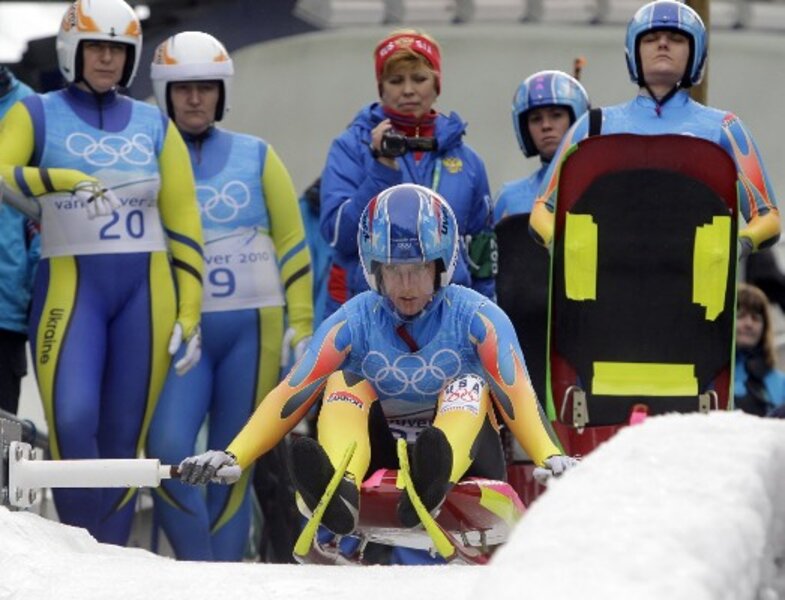Track safer after Nodar Kumaritashvili death, but lugers unhappy
Loading...
| Whistler, British Columbia
At the Whistler luge track Saturday, one day after Nodar Kumaritashvili died in a training crash, the complaints from athletes were more about new safety measures than the decision to begin racing again.
Five sliders – an American, three Canadians, and an Austrian – all respected the International Luge Federation’s (FIL) decision to begin tonight’s men’s event from the womens' start. But none was happy about it.
Moving the race to the womens' start – which cuts top speeds at the world’s fastest track by about six miles per hour – was just one of the security precautions taken by FIL.
It also added a makeshift wooden wall above the exit at turn 16 – the place where Kumaritashvili was thrown from the track and hit a metal pole – and changed the grade of the ice in turn 16 to make it less severe.
But sliders talked mostly about the new start. “It’s significantly slower, significantly easier, and significantly safer,” said American luger Tony Benshoof, who finished fourth in Turin. “But personally, I’d like to go from the top.”
Like his four colleagues, Benshoof was reluctantly supportive of FIL, knowing that “luge is in a tough spot.” But his desire to push the envelope, even now, shows the degree to which danger is sewn into the fabric of winter sports.
The world catches a glimpse of it only every four years – and the glimpse can sometimes be shocking. For winter athletes, however, danger is a part of their daily existence, and the lugers’ willingness to get back to the track Saturday illustrates how they manage to cope with the perpetual prospect of injury or worse.
“People need to finish their runs and get their confidence back,” said Canada's Ian Cockerline.
Danger a part of Winter Olympics
That attitude is perhaps universal among Winter Olympians, a shared code far more profound than “faster, higher, stronger.”
Snowboarder Shaun White is usually the red-headed king of cool. In the pre-Games press conferences, he could have been voted the Athlete Least Afraid of Team USA’s Ralph Lauren Wardrobe. While other athletes arrived in uniforms that were little more than jogging suits, White appeared as if he were headed for a vacation on the Vineyard – a Gatsby of the Winter Games in cap, scarf, and cardigan.
The superpipe gold is his to lose. Yet when he was first learning the trick that virtually guarantees him gold – the double cork – his hands shook with fear, he said.
Then at the X Games, he slammed his face into the side of the pipe during training, his head snapping back violently. The first thought that entered his mind: “I have to get back to the top and try it again,” he said.
It was not bravado, but self-preservation. He did not want to let any fear take root. “I’d be lying if I said that crash didn’t shake me up,” he said.
For American freestyle aerials skier Ryan St. Onge, the fear of not being able to perform is worse than the fear of injury. “Sometimes, if you take a crash really hard and you can get up and take another jump, that actually adds to your confidence,” he says.
To the average real estate agent, that might sound utterly absurd. But in the presence of these athletes, it eventually becomes apparent that the Winter Olympics are a unique mental and physical ecosystem.
To many Winter Olympians, it is not a matter of dealing with fear. The joy of the sport is interlinked with its danger. If downhill skiing were as dangerous as Parcheesi, after all, skiers might go race motorcycles.
“If you’re scared of speed, you can’t do downhill,” says American alpine skier Kailyn Richardson. “There has to be a little bit of craziness.”
Canadian slider Cockerline agreed. “That’s probably why I got into a sport like luge,” he said.
Speed vs. safety
Even after Kumaritashvili’s death, which resonates deeply in the tight-knit luge community, Cockerline acknowledged that moving the race to the women’s start “has taken a lot of the excitement out of it.”
“From the start to turn 11 there’s no speed,” added Austria's Manuel Pfister.
“I love speed,” he said, before adding: “But you have to think about the safety.”
His comments hint at the conflicting thoughts and emotions among lugers Saturday.
“My emotions are going from high to low, high to low,” said Cockerline. “One minute you’ve got tears in your eyes thinking about Nodar, and the next you’re psyching yourself up” for the race.
Coming back and sliding Saturday “says a lot about the luge community,” said Canada's Samuel Edney.
For Edney, the day had been particularly difficult. He had just gotten to know Kumaritashvili at the last World Cup race. “He was excited, thrilled to be coming to Vancouver,” Edney said.
“For me personally, I felt like I was sliding with Nodar today.”
-----
Follow our Olympics Twitter feed.





